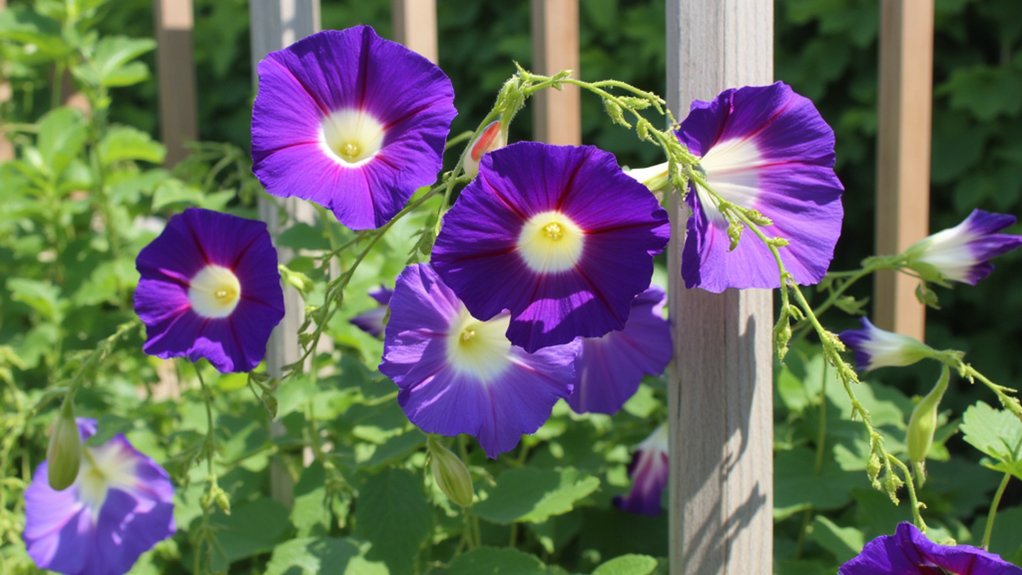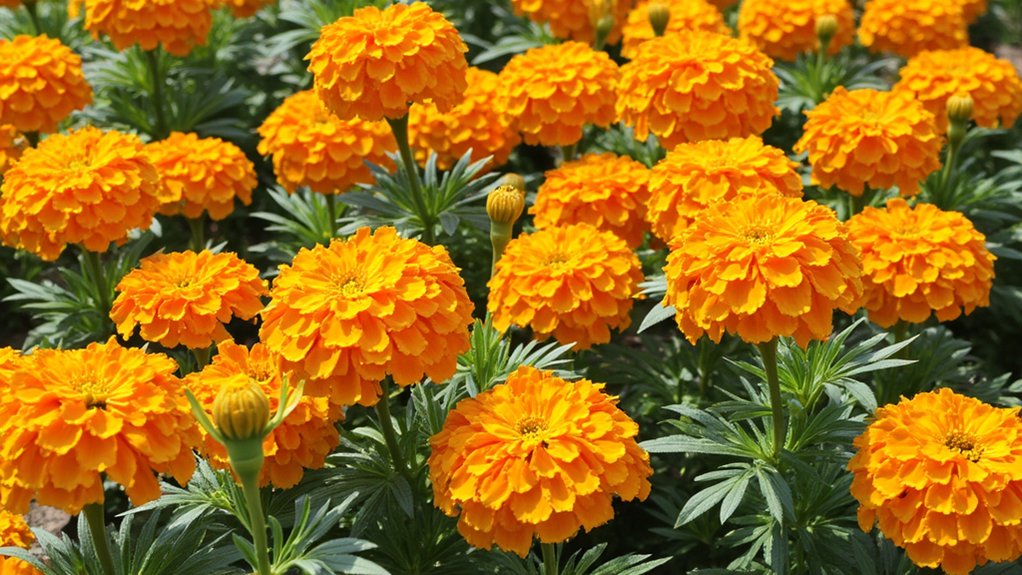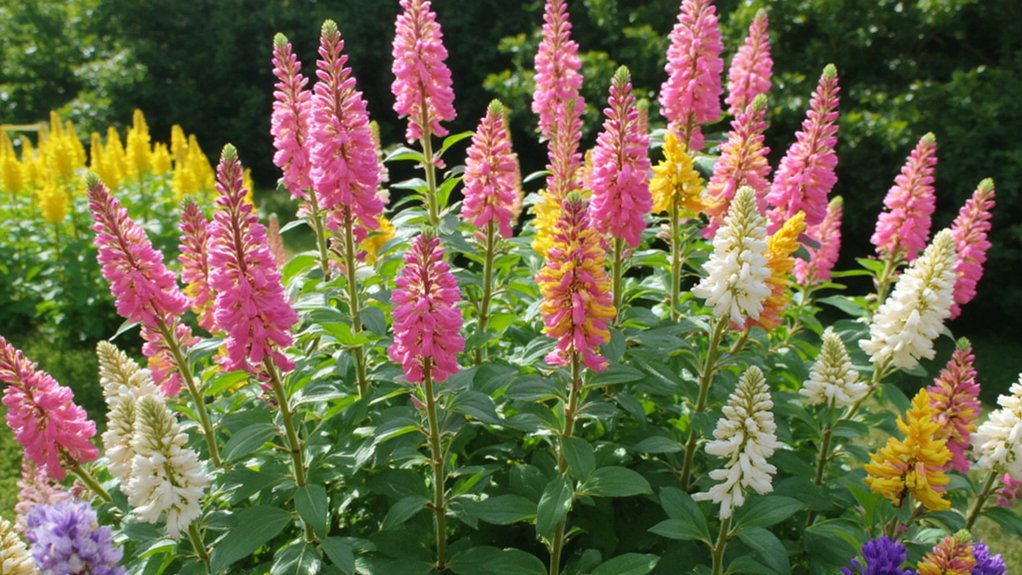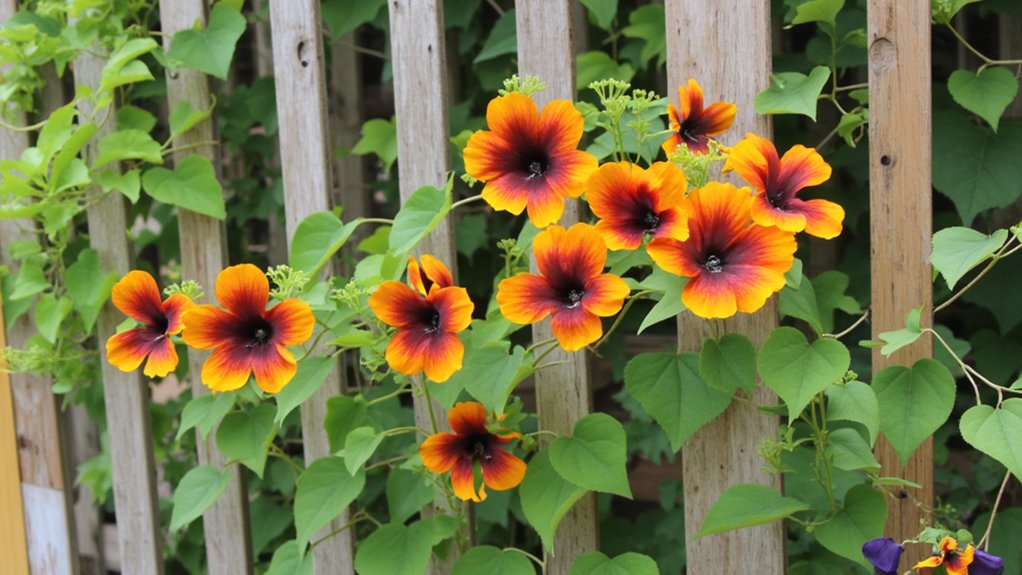Whether you’re dreaming of towering sunflowers or cascading morning glories, you’ll need fast-growing flowers to create your perfect summer garden. These rapid bloomers can transform a bare patch into a vibrant display in just 6-8 weeks, with some varieties growing up to 6 inches per week. You’ll discover how selecting the right combination of quick-growing annuals can give you continuous blooms from June through October’s first frost.
Contents
- 1 Cheerful Morning Glory Blooms
- 2 Vibrant Marigold Clusters Appear
- 3 Sunflowers Tower Above Garden
- 4 Cosmos Flowers Bloom Quickly
- 5 Zinnias Burst With Color
- 6 Quick-Growing Nasturtium Spreads
- 7 Four O’Clocks Open Daily
- 8 Petunia’s Colorful Wave Spreads
- 9 Climbing Black-Eyed Susan Vines
- 10 Dazzling Portulaca Ground Cover
Cheerful Morning Glory Blooms

The vibrant Morning Glory vine can transform your summer garden with its trumpet-shaped blooms in shades of purple, blue, pink, and white. You’ll find these fast-growing climbers reaching heights of 10-15 feet in a single season, making them perfect for covering fences, trellises, or arbors.
Plant your Morning Glory seeds directly in the garden after the last frost, spacing them 6 inches apart and 1/4 inch deep. They’ll germinate faster if you nick the seeds and soak them in water for 24 hours before planting.
Once established, these low-maintenance vines don’t need much fuss. They’ll start flowering about 8-12 weeks after planting, and you can expect new blooms each morning throughout summer. Just keep the soil slightly moist, provide full sun, and watch them climb.
Vibrant Marigold Clusters Appear

While Morning Glories climb skyward, Marigolds bring bursts of sunshine right at ground level in your summer garden. You’ll find these hardy annuals blooming in shades of yellow, orange, and gold within 8 weeks of planting, creating dense clusters that reach 6-12 inches in height.
To get the most vibrant displays, plant your Marigold seeds 1 inch deep and 6 inches apart in well-draining soil. They’ll thrive in full sun and don’t need much water, making them perfect for busy gardeners.
You won’t need to deadhead often, but removing spent blooms every 5-7 days encourages continuous flowering through October. For best results, fertilize monthly with a 5-10-5 blend, and you’ll enjoy these pest-resistant beauties all season long.
Sunflowers Tower Above Garden

Majestic sunflowers can reach towering heights of 12-15 feet in just 90 days, creating dramatic vertical impact in your summer garden. You’ll need to plant your seeds 6 inches deep and 6 inches apart in well-draining soil, ensuring they receive at least 6-8 hours of direct sunlight daily.
For ideal growth, you’ll want to water deeply at the base, about 2 inches per week, and stake plants when they reach 3 feet tall. Once established, sunflowers are drought-tolerant and remarkably low-maintenance.
Choose from varieties like ‘Mammoth Russian’ for maximum height, or ‘Sunforest’ for sturdy stems that won’t need staking. You’ll see seedlings emerge in 7-10 days, and the first blooms will appear in about 60 days, lasting through late summer.
Cosmos Flowers Bloom Quickly

Among summer’s fastest-growing blooms, cosmos flowers will dazzle your garden with prolific blossoms just 7 weeks after planting. You’ll find these easy-care annuals reaching heights of 2-4 feet, with delicate ferny foliage that creates an airy backdrop for their daisy-like flowers in pink, white, and magenta hues.
Plant your cosmos seeds directly in the garden once soil temperatures reach 60°F, spacing them 12-18 inches apart. They’ll thrive in full sun and actually produce more flowers in poor soil, so don’t pamper them with fertilizer or rich compost.
To keep the blooms coming all season, deadhead spent flowers regularly and provide minimal water. You’ll notice that cosmos naturally reseed themselves, ensuring next year’s garden gets a head start without any extra effort from you.
Zinnias Burst With Color

Another star performer in the fast-growing flower category, zinnias deliver an explosion of vibrant color in just 6-8 weeks from seed. You’ll find these hardy annuals in nearly every shade except blue, with heights ranging from 6 inches to 4 feet tall, depending on the variety.
To get the most from your zinnias, plant them in full sun after the last frost, spacing seeds 4-6 inches apart at a depth of 1/4 inch. They’ll thrive in well-draining soil with a pH between 5.5 and 7.5, and you won’t need to fertilize if your soil is reasonably rich.
For continuous blooms throughout summer, deadhead spent flowers and consider staggered planting every two weeks. You can even save seeds from your favorite blooms for next year’s garden.
Quick-Growing Nasturtium Spreads

Fast-growing nasturtiums can transform your garden in just 7-10 days after sprouting, making them one of the quickest flowering plants you’ll ever grow. You’ll find these versatile flowers spreading 12-24 inches wide, with blooms lasting from early summer through the first frost.
Plant your nasturtium seeds 1 inch deep and 10-12 inches apart in well-draining soil, keeping the area moderately moist but not waterlogged. They’ll thrive in full sun or partial shade, adapting to various garden conditions with minimal fuss.
Don’t fertilize these hardy plants – they actually bloom better in poor soil. You can train climbing varieties up trellises or let them cascade over walls, while bush types work perfectly in containers. As a bonus, both the flowers and leaves are edible, adding a peppery kick to summer salads.
Four O’Clocks Open Daily

While most flowers follow the sun’s schedule, Four O’Clocks march to their own drummer, unfurling their trumpet-shaped blooms precisely in the late afternoon around 4 p.m. You’ll find these hardy annuals growing up to 3 feet tall, with blooms in pink, yellow, white, and magenta that release a sweet jasmine-like fragrance.
You can easily start Four O’Clocks from seed, planting them directly in your garden after the last frost. They’ll germinate within 5-7 days and begin flowering about 8 weeks later. Space the seeds 12 inches apart in well-draining soil.
Don’t worry if you’ve got a challenging spot in your garden – these resilient plants tolerate poor soil and partial shade. They’ll self-seed readily, so you won’t need to replant them year after year.
Petunia’s Colorful Wave Spreads

Petunias bring an explosion of color to any garden, with their vibrant waves of blooms spreading up to 4 feet across. You’ll find them especially useful for filling bare spots quickly, as they’ll grow 6-8 inches tall while spreading rapidly throughout summer.
Plant your petunias 12 inches apart in well-draining soil, and you’ll see them establish themselves within 2-3 weeks. They’ll need at least 6 hours of direct sunlight daily to maintain their vigorous growth and continuous blooming cycle.
For the best spreading performance, you’ll want to fertilize every two weeks with a balanced 10-10-10 formula. Don’t forget to pinch back leggy stems by one-third their length, and remove spent blooms weekly to encourage new growth and prevent self-seeding, which can reduce flowering.
Climbing Black-Eyed Susan Vines

If you’re seeking dramatic height in your summer garden, black-eyed Susan vines will rapidly climb 6-8 feet within a single season. These vigorous climbers, also known as Thunbergia alata, produce cheerful orange, yellow, or white blooms with distinctive dark centers from early summer through fall.
You’ll want to plant these vines in well-draining soil once temperatures consistently reach 60°F. Provide them with a sturdy trellis, fence, or arbor to climb, as their tendrils naturally seek support. Space plants 12-18 inches apart for ideal growth.
Unlike their perennial cousin, the traditional black-eyed Susan, these vines are typically grown as annuals in zones 3-8. They’ll thrive in full sun to partial shade and need regular watering, about 1 inch per week, to maintain their rapid growth rate.
Dazzling Portulaca Ground Cover

Moving from vertical climbing vines to low-lying spreaders, Portulaca offers a stunning carpet of color for your summer garden. These heat-loving succulents, also known as moss roses, thrive in full sun and spread 6-8 inches wide per plant, creating a dense mat of vibrant blooms.
You’ll find Portulaca incredibly easy to grow, as it’s drought-tolerant and requires minimal maintenance. Plant them 12 inches apart in well-draining soil, and they’ll fill the space within 3-4 weeks. The flowers open in bright sunlight and close at night or on cloudy days.
For best results, start seeds indoors 6-8 weeks before your last frost date, or purchase young plants in spring. They’ll reward you with continuous blooms in shades of pink, orange, yellow, and white until the first frost arrives.
